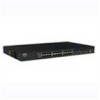Dell PowerConnect 5324 User's Guide - Page 23
Spanning Tree Protocol Features, Link Aggregation
 |
View all Dell PowerConnect 5324 manuals
Add to My Manuals
Save this manual to your list of manuals |
Page 23 highlights
GVRP Support GARP VLAN Registration Protocol (GVRP) provides IEEE 802.1Q-compliant VLAN pruning and dynamic VLAN creation on 802.1Q trunk ports. When GVRP is enabled, the device registers and propagates VLAN membership on all ports that are part of the active underlying "Spanning Tree Protocol Features" topology. For more information, see "Configuring GVRP". Spanning Tree Protocol Features Spanning Tree Protocol (STP) 802.1d Spanning tree is a standard Layer 2 switch requirement that allows bridges to automatically prevent and resolve L2 forwarding loops. Switches exchange configuration messages using specifically formatted frames and selectively enable and disable forwarding on ports. For more information, see "Configuring the Spanning Tree Protocol". Fast Link STP can take up to 30-60 seconds to converge. During this time, STP detects possible loops, allowing time for status changes to propagate and for relevant devices to respond. 30-60 seconds is considered too long of a response time for many applications. The Fast Link option bypasses this delay, and can be used in network topologies where forwarding loops do not occur. For more information enabling Fast Link for ports and LAGs, see "Defining STP Port Settings" or "Defining STP LAG Settings". IEEE 802.1w Rapid Spanning Tree Spanning Tree can take 30-60 seconds for each host to decide whether its ports are actively forwarding traffic. Rapid Spanning Tree (RSTP) detects uses of network topologies to enable faster convergence, without creating forwarding loops. For more information, see "Configuring Rapid Spanning Tree". Link Aggregation For more information, see "Aggregating Ports". Link Aggregation Up to eight Aggregated Links may be defined, each with up to eight member ports, to form a single Link Aggregated Group (LAG). This enables: • Fault tolerance protection from physical link disruption • Higher bandwidth connections • Improved bandwidth granularity • High bandwidth server connectivity Introduction 23















